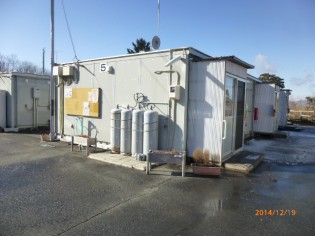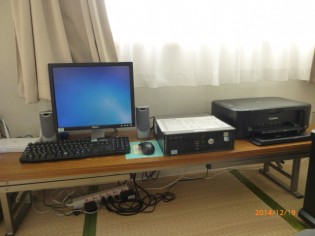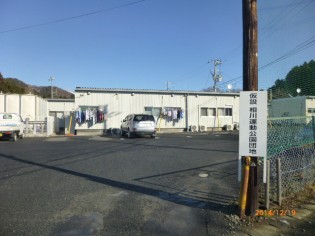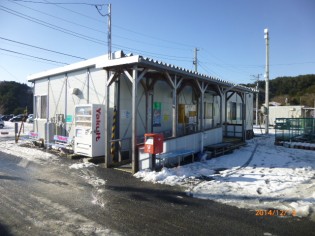December 2014: Report on Local Community Support Project for Disaster Affected People in Ishinomaki City in Miyagi Prefecture, Higashi-Matsushima City, and the Town of Minami-Sanriku
2015.3.12 Thu 15:19
As we enter December, 2014, this year’s top ten news headlines, as well as reflections about this year, have stood out through local newspapers.
We are approaching the fourth year since “The Great East Japan Earthquake of March 11th, 2011.” The rebuilding of homes for people affected by the disaster in Miyagi Prefecture and the Ishinomaki region is taking shape, and the granting of residential land for the disaster prevention group relocation housing has started. In addition, people have been moving into disaster public housing in succession.
There seem to be cases of the elderly feeling more isolated after having moved to permanent housing, as they approach New Year’s Day in a new environment. Therefore, we are taking measures to prevent the people who have moved into the permanent housing from feeling isolated; we have been doing the same for the residents living in temporary housing where increasing number of rooms are becoming vacant. Additionally, the new residents who are relocating from closing temporary housing complexes to new temporary housing facilities are starting to form residents’ associations to create new communities.
With that being said, on December 8th, 2014, the Olympic flame platform was transported to the Ishinomaki City General Athletics Park from Tokyo, using a truck over seven hours. This platform had been temporarily entrusted to Ishinomaki City because of the reconstruction work on the National Olympic Stadium in Tokyo.
The Olympic flame platform from the 1964 Tokyo Olympics became the symbol of Japan’s post-war recovery. It was subsequently placed under the control of the Japan Sport Council. With hopes to recover from the Great East Japan Earthquake, the council decided to temporarily entrust it to Ishinomaki City. The Olympic flame platform is planned to be placed on a completed pedestal in the park, on Yasuragi Square, until March, 2019.
Until the new National Olympic Stadium is completed for use in the 2020 Tokyo Olympics and Paralympics, the platform will watch over the residents of the affected areas, who are all working toward recovery.
●? Computer Training for Residents’ Association Members
We conducted this month’s “Computer Training for Temporary Housing Complex Residents’ Association Members” for Oomori Temporary Housing Unit 3.


We held a training to create flyers for the “Christmas Party,” which was organized by the residents’ association of Oomori Temporary Housing Unit 3. The members learned how to use Word to insert shapes, change colors, and search for related pictures on the internet, subsequently saving them onto their computers. The residents’ association members were very happy looking at the finished flyers.
●? About this Project’s Completion Procedures
BHN started these support activities using designated donations in July, 2012. In December, 2013, the time-frame set for collecting designated donations came to an end, and at the end of December, 2014, we completed our activities.
This project to support the disaster survivors’ local communities started in Higashi-Matsushima City, Miyagi Prefecture. Afterward, we expanded our activities to Ishinomaki City, Tome City, and Minami-Sanriku City. Our specific activities, which were slightly amended during the time period, consisted of the following: 1) Installing computers and printers in 38 temporary housing complex meeting places (in 28 of these temporary housing complex meeting places, we also provided fiber-optic internet connections), and 2) Conducting “Computer Trainings for Temporary Housing Complex Residents’ Association Members” for members who requested training.
As we approached the completion of our activities at the end of December, 2014, we made the final confirmation of the members’ desire for the continued usage of the “fiber-optic internet connection” that was installed in the temporary housing complexes and the “continued usage of installed computers and printers.” We met with the members of Ishinomaki Temporary Housing Self-Government Alliance Secretariat, and got in touch with all the temporary housing complex residents’ association presidents. Through this, we finished confirming whether or not all the residents’ association members of the temporary housing complexes wanted continued usage until the middle of December, 2015.
After learning the results of this, we completed the “internet line contract transfer” for the two temporary housing complex residents’ associations (Oohashi temporary housing complex in Ishinomaki City, as well as Nakasechou Temporary housing complex in the Town of Minami-Sanriku, Motoyoshi-gun) that wished to continue using fiber-optic internet connections” at their own expense. Additionally, for the fifteen temporary housing complex residents’ associations that requested continued usage of installed computers and printers, we concluded an MOU (memorandum of understanding) to enable continued lending of computers to them, and left the computers and printers in the temporary housing complexes to be maintained by themselves.
These fifteen associations were the temporary housing complexes of Oohashi in Ishinomaki City, Minamizakai (Unit 5), Oomori (Unit 3), Iinogawa Senior High School, Ogachi-Tougezaki, Koganebukuro, Oshikirinuma, Momoo Nakatsuyama, Asahi Kasei, Ayukawa Primary School, the Ishinomaki Temporary Housing Self-Government Alliance Secretariat, Takagi no Mori Athletic Park in Higashi-Matsushima City, Kamiku Fureai Park, Shimoku Fureai Park, and Yokoyama in Tome City (Number 1 and 2).


For the temporary housing complexes not listed above, we cancelled the fiber-optic internet connection contracts with NTT, and collected one by one the computers that people had finished using over a long period of time. While collecting these, we received words of thanks and appreciation from all the residents’ association members. We hope that, through the harmonious administration of residents’ associations, these people will be able to return to the lifestyles they led before the earthquake as soon as possible.
We received donations from 16 companies, including Sega Sammy Holdings, Inc., for this local community support project for disaster survivors in Ishinomaki City in Miyagi Prefecture, Higashi-Matsushima City, and the Town of Minami-Sanriku. Through this, we were able to continue our activities until December 31st, 2014. We sincerely thank these companies for their help.
BHN was able to carry out these large-scale internet support activities because, in addition to the financial support above, we received many in-kind donations, including computers, office software, and security software from telecommunications businesses. We take this opportunity to sincerely thank the Microsoft Corporation, the Symantec Corporation, the NTT Plala Corporation, and the All NTT Workers Union of Japan Headquarters, for sending support to us.
● ?About the Efforts from Now on
At the end of December, 2014, we finished our project to collect these designated donations, which we started in July, 2012. We have kept the computers and other devices installed at the fifteen temporary housing complex meeting places for which the members desired continued usage. From now on, while watching over the self-governance of the temporary housing complex residents’ associations, we will continue support activities. In addition, we have decided to maintain the BHN Miyagi Office together with its activities until the end of December, 2015.
Ishinomaki Area Disaster Survivors Support Project Manager: Shuji Arima (Counselor)
English translation by Mariah Gomes
